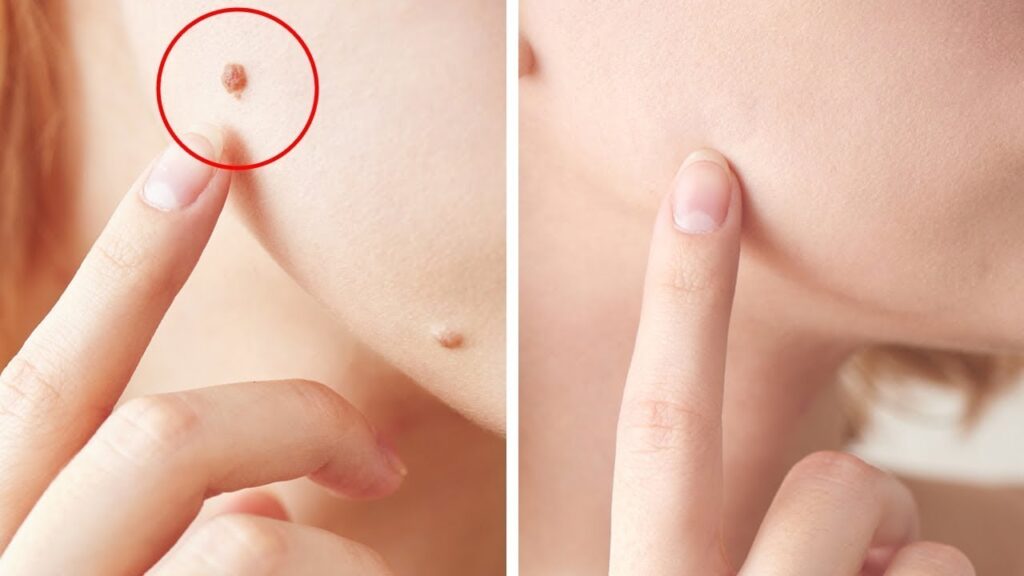Discover How to Remove Moles from Face Naturally at Home
Moles on the face can be a cause of concern for many people. which affect self-esteem. And make people look for ways to remove moles from face naturally. The desire to maintain a clear complexion drives the search for safe and effective ways to get rid of these blemishes. In today’s age, where natural remedies are increasingly valued for their minimal side effects, learning how to remove moles naturally in one day or over a period without resorting to invasive procedures is highly sought after. Certainly, the aesthetic and health aspects of appearance will strongly impair clinical and cognitive approaches to sleep and treatment.

The following content highlights natural ingredients for mole removal. Showing how to get rid of moles at home using readily available and gentle substances on the skin. Key considerations will be addressed regarding the potential risks and precautions to ensure safety during the at-home removal process. Also, it’s important to know when professional help is needed. Because certain types of moles require medical evaluation. Complete with practical advice and appreciate the balance of natural methods and professional guidance. The purpose of this article is to give readers a comprehensive view of this. How to remove a mole on your face properly and responsibly.
Natural Ingredients for Mole Removal
- Garlic: Some believe that garlic can diminish or entirely remove moles due to its enzymes that may dissolve cell clusters. However, caution is advised as garlic can cause skin burns.
- Castor Oil and Baking Soda: A mixture of castor oil and baking soda is thought to create an ointment that could remove moles by drying them out, while the oil protects the skin.
- Oregano Oil: Known for being harsh on the skin, oregano oil should be diluted with a carrier oil like castor oil. Applied regularly, it might help in removing moles.
- Iodine: Applying a specific concentration of iodine over several weeks may cause the mole to flake off. It’s important to handle iodine with care to avoid skin staining.
- Lemon Juice: Frequently applying lemon juice may bleach the mole, making it less noticeable.
- Tea Tree Oil: This essential oil is considered effective for mole removal without causing side effects. However, results can vary based on the mole’s size and depth.
- Potatoes: Potatoes are thought to have a natural bleaching effect which might not remove a mole completely but could help in fading it.
- Flaxseed Oil: While flaxseed oil is rich in omega-3s and might improve skin health, its effectiveness in mole removal is not well-documented.
Using Natural Ingredients to Remove Moles
- Frankincense Oil: Applied daily, frankincense oil is believed to absorb oils and dry the skin, which might lead to the mole drying out and falling off.
- Banana Peels: The enzymes and acids in banana peels are thought to help dissolve mole tissue and moisturize the area, potentially aiding in mole removal.
- Honey: While honey is often touted for its skin lightening effects, its effectiveness in mole removal lacks scientific backing.
- Hydrogen Peroxide: Known for its properties that may help in mole removal, hydrogen peroxide should be used with care to avoid adverse skin reactions.
- Aloe Vera: Aloe vera is praised for its skin-soothing properties. It might not remove moles but can aid in skin healing and lightening around the mole area.
- Coconut Oil: Regular application of coconut oil may reduce the size of the mole, although no studies support its efficacy in mole removal.
Potential Risks and Precautions: How to Remove Moles From Face Naturally
Skin Irritation
People trying to remove moles at home should be careful of skin irritation. This can result from using natural remedies such as garlic or essential oils. Without any proper solution. Skin irritation may appear as redness, swelling or pain. Especially if the mole removal procedure involves harsh substances. Alternatively, If the skin has not been adequately prepared before application
Scarring
Scarring is a significant risk associated with both at-home and surgical mole removal methods.Techniques such as cutting, burning or using mole removal creams can leave scars. which may be similar to the actual mole. Symptoms of mole removal vary. and may become less prominent over time. But in some cases, they can be persistent and significant. which requires further treatment.
Allergic Reactions
Allergic reactions are another potential risk when using over-the-counter mole removal creams or natural substances. These products may contain ingredients that can cause severe allergic reactions, including itching, redness, and swelling. Individuals should be aware of the ingredients and test the product on a small area of skin before full application to minimize the risk of an adverse reaction .
When to Seek Professional Help
Cancerous Moles
It’s crucial to consult a dermatologist if a mole exhibits rapid changes in size, shape, or color, which could indicate skin cancer 7. Persistent itching or bleeding from a mole also necessitates professional evaluation, as these symptoms may signal underlying health risks. Moles with irregular or undefined borders should be examined due to potential abnormal cell growth.
Persistent Moles
If a mole grows back after removal, it’s important to see a healthcare professional promptly. Regular skin checks are essential, especially for individuals with a history of skin cancer or significant sun exposure. Dermatologists recommend an annual skin cancer screening, and more frequent checks if there’s a personal or family history of skin cancer.
Health Conditions Requiring Medical Supervision
For those with a history of melanoma or atypical moles, it’s vital to document the location and date of any previous mole removals and to bring any relevant medical reports to consultations. During appointments, avoid wearing makeup or opaque nail polish, as these can hinder a thorough examination. Always prepare a list of questions and changes observed in moles to discuss with your dermatologist.
Conclusion : How to Remove Moles From Face Naturally
In this lesson we will discuss anti-inflammatory drugs, we will look at different anti-inflammatory drugs from garlic and coconut oil to artificial vegetables like potatoes and coconut oil. They improve their skin. It is important to maintain good oral hygiene. Because the attractiveness of quick home remedies must be balanced with the possibility of skin rashes, redness and allergic reactions.
But in the latter case, it makes sense for most people to want clear skin. And this is common, but the decision to get rid of ticks with home remedies should be taken with caution. The instructions provided here are for the information of the readers. But it also encourages a combination of natural approaches and smart advice. If the spider shows threatening behavior or in the absence of evidence. Finding a vet is even more important.With the information provided in this article readers can make informed decisions about their skin care. Find the right balance between the soothing effects of natural remedies and the wisdom of medical advice.
FAQs
What are some natural methods to remove moles from the face at home?
To remove moles naturally at home, you can use pineapple juice mixed with sea salt as a scrub. Apply this mixture over the mole and scrub the area for 15 minutes to remove the top layer of skin. Use this scrub daily for a week for optimal results. Alternatively, applying aloe vera pulp directly to the mole and allowing it to dry for 2 hours can also be effective.
How can you create a homemade mole removal remedy?
A home remedy for mole removal can be made by mixing castor oil with baking soda to make an ointment. It is believed that when applied continuously for several weeks. That this mixture dries the sesame. While castor oil helps protect the skin.
Is it possible to remove moles using toothpaste?
Using toothpaste to remove moles on the face is not supported by scientific evidence and is considered neither effective nor safe. The American Academy of Dermatology advises consulting a doctor for safe and proper mole removal methods.
Can vinegar be used to remove moles on the face?
While apple cider vinegar might chemically burn the skin and potentially remove moles, it can also cause complications. Therefore, it is recommended to seek professional medical advice for mole removal to ensure the mole can be appropriately tested for skin cancer. Moles, also known as nevi, are common skin growths that usually appear as small, round, brown spots.
